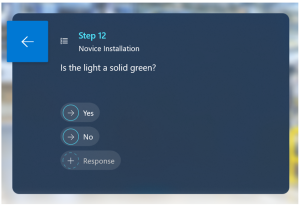Part 2 on key scenarios to utilize Guides branching feature will cover on the job scenarios. While we have identified these scenarios are ideal for on the job some may serve as a dual purpose for training scenarios as well. If you have not read part 1 on training scenarios, be sure to check that blog out here.

Prep and Safety
As cheesy as it sounds safety is the one priority. A simple prep and safety branching step can be the difference between an employee stepping on the frontline with or without their Personal Protective Equipment (PPE). This step serves as a nice remainder for users who might forget one minor thing during safety checks. If companies notice a frequently forgotten step employees forgot about, this is the prefect use case for this scenario. This can be a single step or longer and serve as a refresher orientation like checklist to follow.
Another way to utilize branching for prep and safety is spatial triggers. By combing branching with spatial triggers warnings, safety precautions will have a greater effect. To add on to the example from above about PPE, companies can implement spatial triggers to warn employees of dangerous situations. In training environments where trainees are new to processes and procedures, they can easily forget about a safety check. This would be another valuable use of this scenario.
Error Messages/Code
The whole idea behind using branching for error messages and codes is users can respond to real time error messages with the correct troubleshooting steps. For example, when a machine on the factory line stops working and an error code alerts to the problem. Users will be able to match the error code within the branching step within Guides and be placed in the correct workflow to correctly identity the issue, troubleshoot, and fix the solution. The troubleshooting steps are the same thing as what subject matters experts (SME) would do and frees SME time to solve more complex problems.
Completion/Validation
A completion/validation branching scenario can be utilize for both training and on the job. We covered knowledge checks and diagnoses scenario to help employees understand terms and processes. A completion/validation step or steps makes sure employees have correctly completed the task at hand. They can validate a step or complete processes like whether a part has been installed correct or the entire machine has been built successful.
Remediation
After employees have identified potential issues, the next logical step is to resolve these issues. A remediation branching guide will handle what to do after a problem appears on the frontline and then how to fix the issue. If employees cannot fix the solution themselves the guide can point on what to do next. That could be call a subject matter expert or replace the part.
Now that you have learned about the different ways you can utilize Guides branching feature hopefully you will implement these scenarios into your business operations. Remember the following listed potential use cases are only a few potential uses to show you how to utilize branching. You may develop your own different ways to use utilize branching to best meet your needs.












More Stories
Sarb hike: 50bps or 25bps?
Funds take record short position across U.S. Treasuries curve: McGeever
Philips buys Israeli co DiA Imaging Analysis